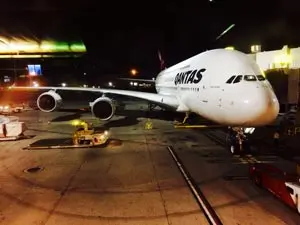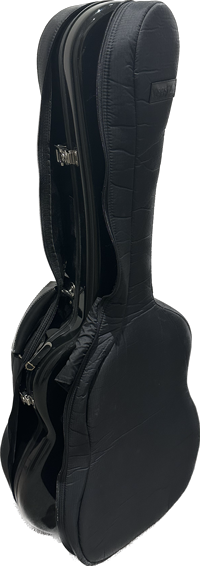I’m sure I’m not alone when I say I love my guitar. The bond between a guitarist and their instrument is formed through countless hours of practice, exploration, and performance. It’s no wonder that when it comes to travel, especially flying, we want to do everything we can to keep our cherished guitar safe. Family, partners, and friends might not fully understand, but to us, our guitar is more than just wood and strings—it’s a companion.
Unfortunately, air travel can be stressful for both musicians and their instruments. We’ve all heard horror stories of guitars getting damaged or destroyed in transit—whether it’s a soundboard punctured by a curious security officer or a guitar case getting crushed in a luggage hold. Checking in an instrument without knowing the risks can turn your prized possession into little more than toothpicks by the time it lands.
But after years of flying—many of them long-haul trips—I’ve learned a few strategies to keep my guitar safe while flying, and I’m happy to share them with you.
How to get your guitar on the plane as cabin-luggage
1. Know Airline Policies for Instruments
Airline policies can differ widely when it comes to carrying guitars on board, so it’s essential to research ahead of time. Here are a few examples from major U.S. airlines in 2024:
- American Airlines: Small musical instruments can be carried onboard if they meet carry-on size requirements and fit in the overhead bin or under the seat in front of you. Instruments are treated as your carry-on item, so you’re allowed a personal item in addition to your guitar.
- Delta Airlines: Guitars are accepted as carry-on items, provided they fit in the overhead bin or other approved cabin storage. If there’s no space, the instrument will have to be checked, and fees may apply.
- United Airlines: You’re allowed to bring a guitar as a carry-on item if it can fit in the overhead bin or under the seat. If no space is available, you’ll need to check it.
- Southwest Airlines: Musical instruments are allowed as carry-on items, but they must fit in the overhead bin or other designated storage. If you’re concerned, you can always purchase a separate seat for your guitar.
Keep in mind that these policies can change, so always check with the airline before booking your flight.
2. Keep Your Cool
When dealing with airport staff, it’s important to stay calm and courteous. Even if you know you’re within the airline’s rules, it’s the flight attendants, gate agents, and security personnel who have the final say. Being aggressive or demanding won’t help your cause.
Instead, be polite and respectful. A little kindness can go a long way, and you’d be surprised how often a smile can make all the difference. I once had a pilot personally take my guitar into the cockpit with him, simply because I asked nicely.
Scenario 1 (What NOT to do):
- Flight Attendant: “I’m sorry, but your guitar exceeds the carry-on size limit.”
- You: “What?! I just saw someone take a massive sombrero and a dog in a carrier onboard, and you won’t let me take my guitar? This instrument is fragile and worth a fortune!”
- FA: “You’ll need to check it, sir.”
Result: Your guitar ends up in the cargo hold, and you’re left praying it survives the trip.
Scenario 2 (A better approach):
- Flight Attendant: “I’m sorry, but your guitar is too large for carry-on.”
- You: “I understand. Would it be possible to see if it fits in the overhead bin or a closet? If not, I’ll check it.”
- FA: “Sure, let’s see if we can make it work.”
Likely result: Your guitar makes it onboard, and you’re much less stressed.
3. Be Discreet
There’s no way around it—your guitar is oversized for most airline carry-on limits. But that doesn’t mean you have to draw attention to it. When checking in, choose a friendly-looking staff member if possible, and keep your guitar low-key.
At security, your guitar is unlikely to be the biggest concern. Just make sure you’re not carrying any prohibited items in your case (music stands, for instance, can look suspicious on an X-ray). Once you get to the boarding gate, keep your guitar out of the staff’s immediate sightline and remain calm and professional when interacting with attendants.
4. Know Your Plane
 Different airplanes have different storage capacities, and smaller planes often can’t accommodate a guitar in the overhead bin. If you’re flying on a Boeing 737, 747, 757, 767, 777, or an Airbus A320, A321, or A380, you should be fine. But smaller commuter planes, like the Dash-8 or Embraer jets, probably won’t have room, so be prepared to check your guitar or consider flying on a larger plane if possible.
Different airplanes have different storage capacities, and smaller planes often can’t accommodate a guitar in the overhead bin. If you’re flying on a Boeing 737, 747, 757, 767, 777, or an Airbus A320, A321, or A380, you should be fine. But smaller commuter planes, like the Dash-8 or Embraer jets, probably won’t have room, so be prepared to check your guitar or consider flying on a larger plane if possible.
Even if your guitar does not fit in the overhead bin there will often be a cupboard somewhere on the plane that can fit your guitar. See if you can stash your instrument in a cupboard before it fills up.
5. Make the Most of Status
Frequent flyer programs offer a key advantage for traveling with a guitar: early boarding. Boarding early increases your chances of securing overhead space for your instrument. If you travel often, enrolling in a program can make this process much smoother.
6. Invest in a Quality Case
A sturdy, well-fitting case is one of the best investments you can make for your guitar. While cases like the Hiscox provide solid protection, high-quality cases like those from Visesnut are smaller and more form-fitting, making it easier to get them accepted as carry-ons.
7. The “Case Case”
 Some high-end cases come with a lightly padded soft case that covers your hard case. That’s right, a case for your case. I have used these for the past twenty years and found that flight attendants often presume the guitar is only protected by a soft case and are more likely to search for a secure spot in the cabin, as opposed to immediately checking it. I won’t lie if they ask what kind of case it is, but I won’t correct their assumption either.
Some high-end cases come with a lightly padded soft case that covers your hard case. That’s right, a case for your case. I have used these for the past twenty years and found that flight attendants often presume the guitar is only protected by a soft case and are more likely to search for a secure spot in the cabin, as opposed to immediately checking it. I won’t lie if they ask what kind of case it is, but I won’t correct their assumption either.
8. Ask to Gate-Check your Guitar
If all else fails and you’re required to check your guitar, ask to “gate-check” it. This means the guitar will be placed in the cargo hold, but it will be handled manually and returned to you at the gate after the flight. This reduces the risk of it being tossed around by automated luggage systems.
What to do if you have to Check your Guitar
If you travel enough you will inevitably have to check your instrument into the main luggage hold. Here are some quick tips to prepare your guitar for getting checked:
1. Prepare your guitar for safe travel
Before heading to the airport, ensure that your guitar is secured properly inside its case. Remove any loose items, like tuners, capos, or sheet music, that could shift during transport. Even small objects can cause scratches or dents, particularly to the soundboard or neck of your guitar.
De-tuning the strings by a half-step is a useful precaution to reduce tension on the neck. This step can help prevent any unnecessary stress that might arise from changes in air pressure or handling during the flight.
Additionally, it’s important to make sure your contact information is visible both inside and outside the case. For international travel, include an email address in case your phone doesn’t work abroad, giving the airline or airport staff multiple ways to reach you in case of lost luggage.
2. Track Your Guitar with GPS
Since the pandemic, it has become more common for checked luggage to get lost or delayed. To reduce stress in case your guitar is checked and lost in transit, consider investing in a tracking device like an Apple Airtag or a similar Bluetooth tracker. This allows you to monitor your instrument’s location in real-time.
Several students from our Classical Guitar Summer School use this strategy, and it has proven helpful. One international traveler had to inform the airline of the exact location of his guitar to get it moving again. Having this level of control can make a huge difference if your luggage goes missing!
3. Insure Your Guitar
No matter how careful you are, accidents can happen. That’s why it’s crucial to insure your guitar, especially if it’s expensive or irreplaceable. Look for insurance policies that cover damage or loss during travel, and make sure you understand the fine print.
If you know ahead of time that you are not going to get your guitar on-board, take a photo of your instrument before travel in-case you need to file an insurance claim.
4. Consider a Travel Guitar
If you’re going on a trip that doesn’t involve performances, consider taking a travel guitar or a less valuable instrument. Many companies now make high-quality travel guitars that are easier to pack and don’t require you to stress about every bump and jostle.
5. Tick Tick
Lastly, don’t forget to turn your metronome off…
Care to share?
If you have a story to share or advice to dispense please do so in the comments below. Good luck with your next trip!


I bought a guitalele ( with nylon strings ) for my travel in Europe. I am able to put it in my luggage ( 30 inches high luggage ). I am a beginner but I could not imagine being 6 weeks without playing. I have my sheet music on my iPad so … life is beautiful
Buying a second seat for your guitar may not work. I did that for a flight from Portland to New York. I checked it in and had it strapped in the seat next to me but was told I couldn’t leave it there for take off. They found closet space for it and I had the comfort of an empty seat next to me!
Useful article. Perhaps a mention of rare wood guitars (CITAS?) would be instructive too.